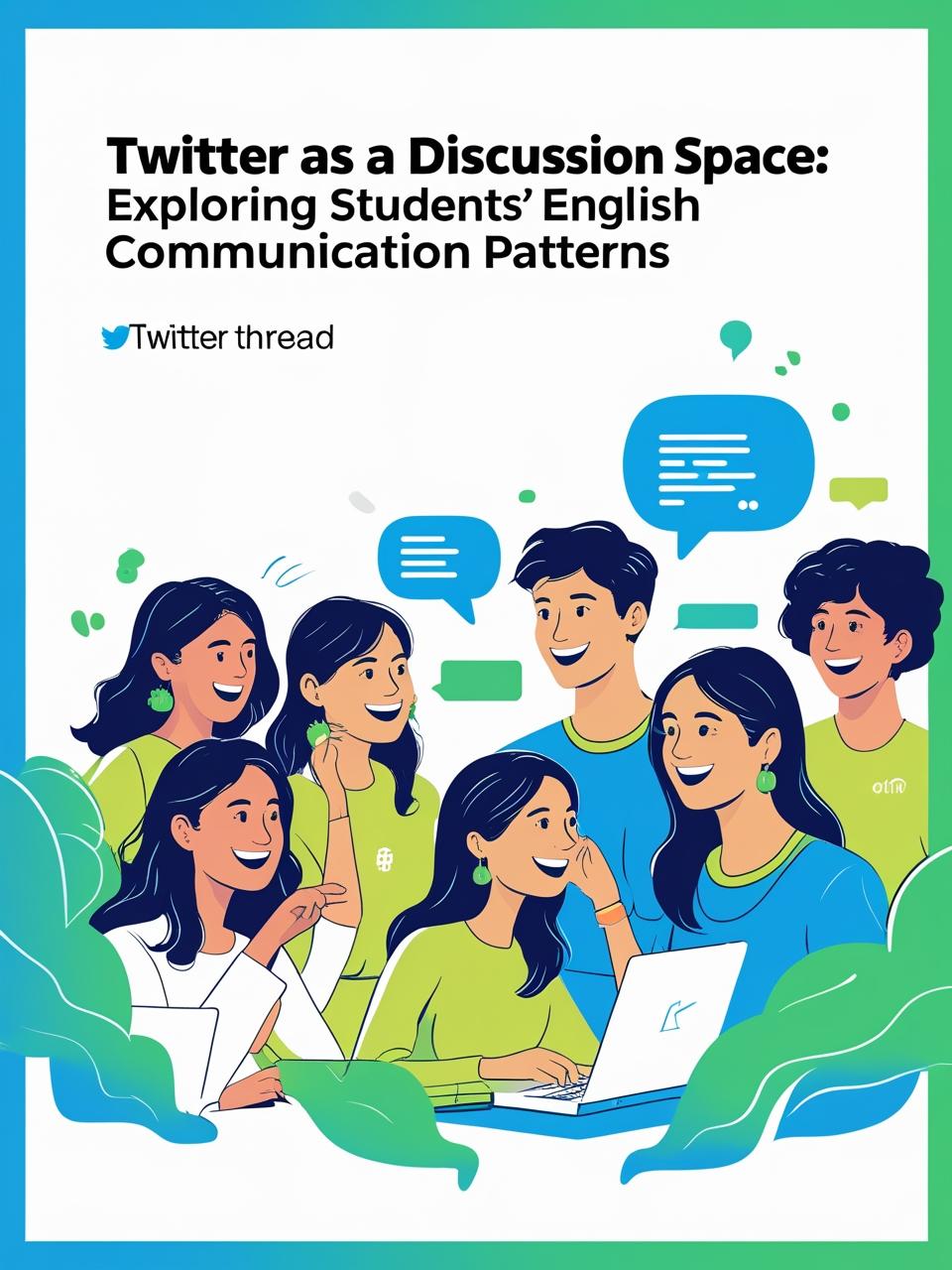Twitter as a Discussion Space: Exploring Students' English Communication Patterns
DOI:
https://doi.org/10.24903/bej.v7i2.2081Keywords:
Twitter, English language learning, informal learning, digital communication, peer interaction, language acquisition, social media, narrative inquiryAbstract
This study investigates how students in the English Department at Mulawarman University use Twitter as an informal platform to improve their English communication skills. Unlike traditional classrooms, Twitter offers a relaxed, real-time environment where students interact in English through tweets, slang, memes, and interactions with classmates. Using a qualitative narrative research approach, data were collected from six students and one instructor through semi-structured interviews. Thematic analysis revealed three main findings: students learn English informally through daily practice and self-motivation; they adapt to a flexible communication style influenced by online slang and global discourse; and they benefit from peer interactions that provide feedback, vocabulary models, and confidence-building. This study concludes that Twitter functions not only as a social media tool but also as a dynamic space for authentic, self-directed, and culturally embedded language learning. Unlike previous studies that focus on the formal integration of social media in education, this research highlights the non-academic motivations driving meaningful engagement with English. While acknowledging limitations such as deliberate sampling and digital access, this study offers new insights into how digital platforms support socio-linguistic language development. The research recommends further investigation into long-term impacts and broader student populations to understand the educational value of informal digital learning environments.References
Alhassan, Y. S. M. (2024). Pedagogy Potential of Social Media in Saudi Arabia Curricula : students ’ and teachers ’ perceptions and practices Author : Yousef Saleh Mohammed Alhassan PhD Dissertation University of Limerick Supervisors : Faculty of Arts , Humanities and Social Scienc.
Aminah, S., Nur, D. R., & Ariyanti, A. (2019). An Analysis of Teacher Talk used by English Teacher at SMKN 5 Samarinda. Borneo Educational Journal (Borju), 1(1), 22–28. https://doi.org/10.24903/bej.v1i1.256
Ana Rahmayani, F., Nurfitria Febriarini, A., Airlangga, U., & Sunan Ampel Surabaya, U. (2021). Fitri Ana Rahmayani, & Any Nurfitria Febriarini A Virtual Ethnograpic study: Memes by Army and Communication Style Through Twitter A VIRTUAL ETHNOGRAPHIC STUDY: MEMES BY ARMY AND COMMUNICATION STYLE THROUGH TWITTER PLATFORM. Platform CaLLs, 7.
Arbain, A., & Nur, D. R. (2017). Techniques for teaching speaking skill in Widya Gama Mahakam University. Script Journal: Journal of Linguistics and English Teaching, 2(1), 13–25. https://doi.org/10.24903/sj.v2i1.80
Arbain, A., & Rohman, A. (2023). Dubbing as a Pedagogical Tool: An Experimental Study on Eleventh-Grade Students at SMAN 8 Samarinda. EDUCASIA: Jurnal Pendidikan, Pengajaran, Dan Pembelajaran, 8(2), 147–156. https://doi.org/10.21462/educasia.v8i2.155
Arbain, A., Taufik, A., & Nur, D. R. (2017). Daily English Phrases Book. UWGM Press.
Blattner, G., & Lomicka, L. (2012). Facebook-ing and the Social Generation: A New Era of Language Learning. Alsic, Vol. 15, n°1(September). https://doi.org/10.4000/alsic.2413
Borau, K., Ullrich, C., Feng, J., & Shen, R. (2009). Microblogging for language learning: Using twitter to train communicative and cultural competence. Lecture Notes in Computer Science (Including Subseries Lecture Notes in Artificial Intelligence and Lecture Notes in Bioinformatics), 5686 LNCS(500), 78–87. https://doi.org/10.1007/978-3-642-03426-8_10
Elavsky, C. M., Mislan, C., & Elavsky, S. (2011). When talking less is more: Exploring outcomes of Twitter usage in the large-lecture hall. Learning, Media and Technology, 36(3), 215–233. https://doi.org/10.1080/17439884.2010.549828
Erliana, U., & Arbain, A. (2020). The Effectiveness of Using Video Clip in Teaching English Vocabulary at SD Fastabiqul Khairat Samarinda. IJOTL-TL: Indonesian Journal of Language Teaching and Linguistics, 5(2), 123–134. https://doi.org/10.30957/ijoltl.v5i2.623
Gracella, J., & Rahman Nur, D. (2020). Students’ Perception of English Learning through YouTube Application. Borneo Educational Journal (Borju), 2(1), 20–35. https://doi.org/10.24903/bej.v2i1.623
Greenhow, C., & Robelia, B. (2009). Old communication, new literacies: Social network sites as social learning resources. Journal of Computer-Mediated Communication, 14(4), 1130–1161. https://doi.org/10.1111/j.1083-6101.2009.01484.x
Kim, B., Park, H., & Baek, Y. (2009). Not just fun, but serious strategies: Using meta-cognitive strategies in game-based learning. Computers and Education, 52(4), 800–810. https://doi.org/10.1016/j.compedu.2008.12.004
L. S. Vygotsky. (1978). Mind in society: The development of higher psychological processes. L. S. Vygotsky. In Sustainability (Switzerland) (Vol. 11, Issue 1).
Malik, Z., & Haidar, S. (2020). English language learning and social media: Schematic learning on Kpop Stan twitter. E-Learning and Digital Media, 18(4), 361–382. https://doi.org/10.1177/2042753020964589
McCulloch, G. (2019). Because Internet Understanding the New Rules of Language.
Nur, D. R. (2020). Virtual Reality adoption in Indonesia higher Education from lecturer’s voice. English Teaching Journal: A Journal of English Literature, Language and Education, 8(1), 31–35. https://doi.org/10.25273/etj.v8i1.6672
Nur, D. R., & Jamilah, J. (2022). English Language Imperative Level in Indonesia. Intensive Journal, 5(1), 36–43. http://dx.doi.org/10.31602/intensive.v5i1.5986
Prestridge, S. (2014). A focus on students’ use of Twitter - their interactions with each other, content and interface. Active Learning in Higher Education, 15(2), 101–115. https://doi.org/10.1177/1469787414527394
Rosell-Aguilar, F. (2018). Twitter: A professional development and community of practice tool for teachers. Journal of Interactive Media in Education, 2018(1), 1–12. https://doi.org/10.5334/jime.452
Tenenbaum, H. R., Winstone, N. E., Leman, P. J., & Avery, R. E. (2020). How effective is peer interaction in facilitating learning? A meta-analysis. Journal of Educational Psychology, 112(7), 1303–1319. https://doi.org/10.1037/edu0000436

Downloads
Published
How to Cite
Issue
Section
License
Copyright (c) 2025 Setoaji Putra, Syamdianita Syamdianita, Aridah Aridah, Desy Rusmawaty, Ventje Jany Kalukar

This work is licensed under a Creative Commons Attribution 4.0 International License.
Authors retain copyright and grant the journal right of first publication with the work simultaneously licensed under a Creative Commons Attribution 4.0 International License that allows others to share the work with an acknowledgment of the work's authorship and initial publication in this journal.



